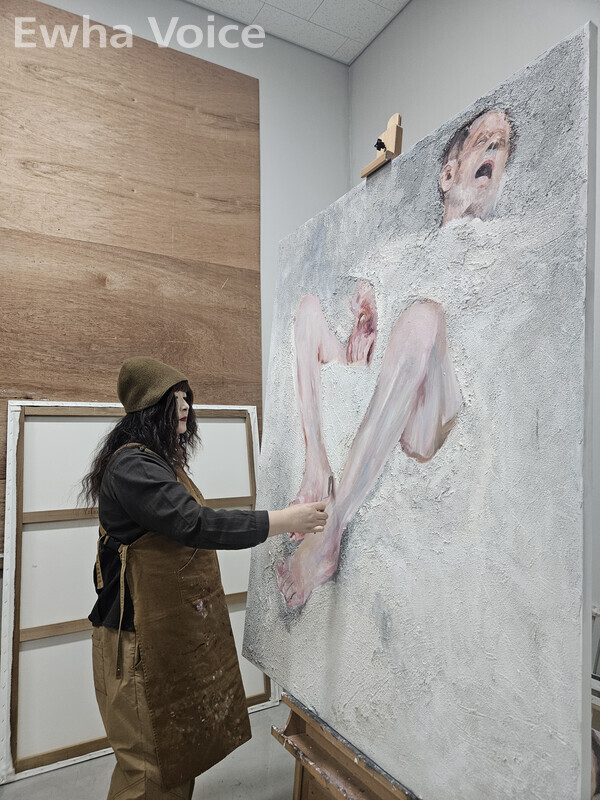
The delicate brush strokes of regardful artists often convey emotions from certain scenes better than descriptive words or detailed letters. Lee Inhae, a realistic figure painter, has devoted her life to this kind of communication through her artworks that depict nameless individuals and historical victims.
After graduating from College of Art & Design’s painting major in 1984, Lee left for Saint Petersburg, Russia to further pursue her studies in arts. During her 15-year stay, she found out how figure drawings can reflect affection for one’s society. Whether those described within the artwork were influential or not, Lee learned that portraits have great power sometimes even enough to move the world. However, figure drawings were not yet mainstream in South Korea upon her return, which motivated Lee to choose figure artworks as her vocational field.
“I have dreamed of leaving meaningful pieces behind in this world before I become too old,” Lee said. “Maybe that is why I am known as a practical artist working on historical representation.”
Lee has dedicated herself to describing individuals facing sorrow or existential crisis as well as representing the weak and the exploited on her canvas. Her fifth private exhibition “A Deep Sleep” and “The Room of Memories,” held from March 6 to 18 at Gallery Insa Art, was the ideal project to express these values through paintings.
“A Deep Sleep” consists of Lee’s selections from her formal pieces, portraying the concept of slumber. Lee wanted to show that the time we fall asleep and cannot see ourselves is the one truly comfortable and subjective moment that everyone shares.
Lee intended the audience to consider her artworks without constraints. Although she herself connected the concept of slumber to those images of the abyss, dreams, liberty, and death, Lee stated that the audience can make deeper interpretations of her creations by reconstructing the meaning with frank sensations.
“To know what the audience felt was especially important for this exhibition, with 38 portraits categorized for ‘The Room of Memories’ illustrating war victims who were so-called comfort women,” Lee mentioned. “I was pleased with the considerable number of people who told me that my works truly touched their hearts.”
“The Room of Memories” was planned to depict the victims of Japanese Military Sexual Slavery. Out of 240 victims, Lee painted portraits of 35 South Koreans and three people from other countries under the permission for the work to realistically record those erased victims of history. She explained that it was a project she had been thinking about for a long time.
“Although I had planned for this project to highlight the historical victims of war, especially women who are vulnerable in wartime, it was difficult to organize my thoughts into artwork for their existential significance in society,” Lee explained.
Lee had pondered for a long time how she could accurately represent the respect she felt for the models. The portraits were painted on hanji, traditional Korean paper, to emphasize the era in which they had lived and suffered. The background of the portraits, colored with sepia and gray, shows the gravity and solemnity Lee felt for the models’ lives.
“After I decided to represent their faces realistically to prove their existence, I needed to connect myself to these elderly women since I had started my work with only their photographs,” Lee reminisced. “However, despite my concerns about sympathizing with the models, I was truly attached to them watching the bright smiles on their faces during the process.”
The Korean Council for Justice and Remembrance, the organization that provided the models’ photos to Lee, visited the exhibition and admired her meaningful work. Lee felt gratitude for their appreciation, since she was delighted to know that she had successfully recreated the models’ realities through her artwork.
“They were already masterpieces needing nothing more or less. I concentrated on portraying every single wrinkle on their face to illustrate the history they had lived,” Lee added. “By doing so, I experienced the path of their lives, since I usually develop the faces I draw from their early childhood to the present when working. It was such an emotional experience to follow the journey of their lives with my brush.”
Lee is contemplating to extend her exhibition into a national tour. Since the exhibition was quite successful for her with many foreign visitors, Lee shared her pleasure with the message her paintings introduced to the public.
“The fear and anxiety about war have become a bigger part of my life because I have a daughter currently studying in Russia,” Lee said. “Not only did I want to remember the historical victims who were brave enough to be heroes by surviving the war, but I also longed to deliver a message about peace and human rights.”

